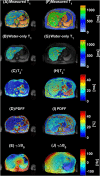Mapping tissue water T1 in the liver using the MOLLI T1 method in the presence of fat, iron and B0 inhomogeneity
- PMID: 30462873
- PMCID: PMC6492199
- DOI: 10.1002/nbm.4030
Mapping tissue water T1 in the liver using the MOLLI T1 method in the presence of fat, iron and B0 inhomogeneity
Abstract
Modified Look-Locker inversion recovery (MOLLI) T1 mapping sequences can be useful in cardiac and liver tissue characterization, but determining underlying water T1 is confounded by iron, fat and frequency offsets. This article proposes an algorithm that provides an independent water MOLLI T1 (referred to as on-resonance water T1 ) that would have been measured if a subject had no fat and normal iron, and imaging had been done on resonance. Fifteen NiCl2 -doped agar phantoms with different peanut oil concentrations and 30 adults with various liver diseases, nineteen (63.3%) with liver steatosis, were scanned at 3 T using the shortened MOLLI (shMOLLI) T1 mapping, multiple-echo spoiled gradient-recalled echo and 1 H MR spectroscopy sequences. An algorithm based on Bloch equations was built in MATLAB, and water shMOLLI T1 values of both phantoms and human participants were determined. The quality of the algorithm's result was assessed by Pearson's correlation coefficient between shMOLLI T1 values and spectroscopically determined T1 values of the water, and by linear regression analysis. Correlation between shMOLLI and spectroscopy-based T1 values increased, from r = 0.910 (P < 0.001) to r = 0.998 (P < 0.001) in phantoms and from r = 0.493 (for iron-only correction; P = 0.005) to r = 0.771 (for iron, fat and off-resonance correction; P < 0.001) in patients. Linear regression analysis revealed that the determined water shMOLLI T1 values in patients were independent of fat and iron. It can be concluded that determination of on-resonance water (sh)MOLLI T1 independent of fat, iron and macroscopic field inhomogeneities was possible in phantoms and human subjects.
Keywords: MOLLI; NAFLD; fat; iron; off-resonance; shMOLLI.
© 2018 The Authors. NMR in Biomedicine published by John Wiley & Sons Ltd.
Figures







References
Publication types
MeSH terms
Substances
Grants and funding
LinkOut - more resources
Full Text Sources
Other Literature Sources
Medical
Molecular Biology Databases

